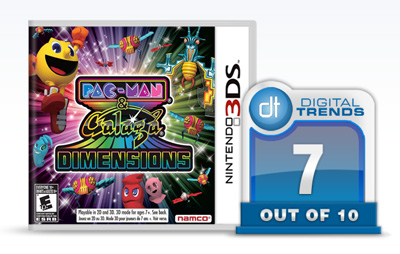 Namco has released a compilation featuring two games you may have possibly heard of: Pac-Man and Galaga. Actually, if you haven’t heard of them, there is something very wrong with you. Both games have become iconic and part of the cultural zeitgeist. The Pope knows who Pac-Man is. The Dhali Lama is wicked at Galaga (well, he might be, but odds are he at least knows the game). So it isn’t all that surprising to see yet another collection featuring the originals introduced to a new platform. It was bound to happen inevitably, and this time the two classic games brought a few friends.
Namco has released a compilation featuring two games you may have possibly heard of: Pac-Man and Galaga. Actually, if you haven’t heard of them, there is something very wrong with you. Both games have become iconic and part of the cultural zeitgeist. The Pope knows who Pac-Man is. The Dhali Lama is wicked at Galaga (well, he might be, but odds are he at least knows the game). So it isn’t all that surprising to see yet another collection featuring the originals introduced to a new platform. It was bound to happen inevitably, and this time the two classic games brought a few friends.
Pac-Man & Galaga Dimensions features six games in total: the original Pac-Man, the original Galaga, 2007’s downloadable Pac-Man Championship Edition, 2008’s downloadable Galaga Legions, and the new Pac-Man Tilt and Galaga 3D Impact. All six games are fairly entertaining, and there is nothing wrong with any of them, but there is nothing you haven’t seen here before.
The original games are what they always were, and they are no surprise. They are still fun to play, just like they have been for the past three decades. Pac-Man CE and Galaga Legions are both fun games as well, and both honor their respective franchises, just as they did when they were released a few years ago as downloadable titles. They aren’t very deep, but they are entertaining.

Of the six games, the two newest are actually the weakest. The original games will always retain a certain nostalgic charm if nothing else, but the two new additions: Pac-Man Tilt and Galaga 3D Impact come up short. Neither are bad, but nor are they good. Pac-Man Tilt is essentially a lesser version of Sonic the Hedgehog, complete with a character that turns into a ball and collects items while speeding around a scrolling map. You have springs, ramps and bright colors (although there just seem to be colors and no real designs beyond neon blocks and brightly colored walls), just like the original Sonic. The only difference is that Pac-Man the hedgehog requires you to physically move the 3DS to control certain aspects of the game, including platforms and walls. When you are playing in 3D, this is not a good thing. It can cause eyestrain quickly when you continually have to readjust to the 3D, and both new games are guilty of it. Its easier just to turn the 3D off.
Galaga 3D Impact is an on-rails shooter, with a handful of weapons at your disposal, and plenty of things whizzing by you at epileptic-inducing speeds. To attack enemies you can either line up the crosshairs with the analog or D-Pad, or tilt the 3DS that direction. The titling is a neat gimmick, but incredibly impractical for a fast-paced game. Plus you look like an idiot while controlling it. You have a handful of weapons at your disposal, and the backgrounds are attractive, but the game is so short it is hard to call it a full game — five levels of 5 to 10 minutes each, max—and there is no way to save.
There is nothing wrong with Pac-Man & Galaga Dimensions. The games all have their own amusement to be squeezed out of from the original games to the new ones, but as far as compilations go, Namco should have compiled a bit more. The package just doesn’t merit the price tag. The new games are short and not really much more than gimmicky mini-games, while the original games can be found on even the most basic cell phones. The middle games, Pac-Man CE and Galaga Legions are both solid, but they aren’t enough to sell the compilation on their own. But, if you are a fan of both franchises, then you may find plenty to like.
Score: 7 out of 10
(This game was reviewed on the Nintendo 3DS on a copy provided by Namco Bandai)


